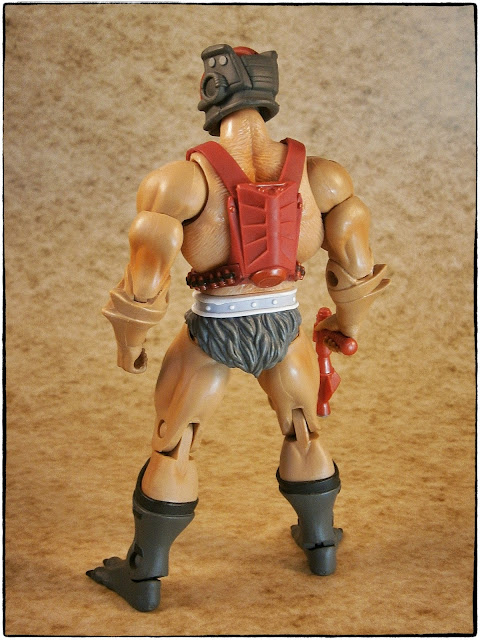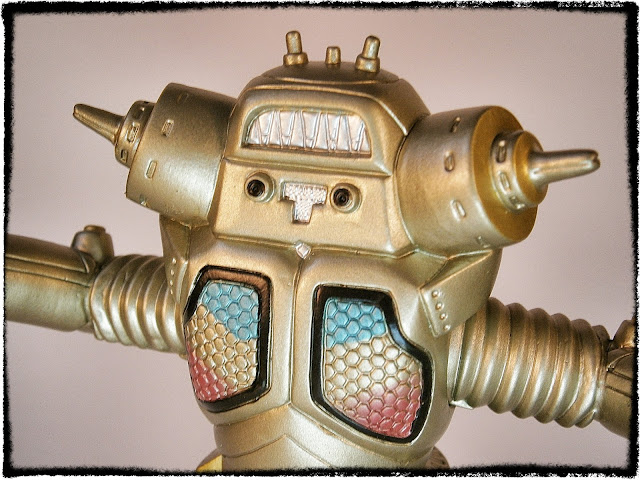
Here's a character that I always loved as a kid. I'm not really sure why, though. When compared to most other Masters of the Universe (MOTU) characters, Zodac (not "Zodiac") is a bit on the dull side. He's got little in the way of bright colors, and really no special features. He's even only got the one real accessory. Beyond that, Zodac hardly ever put in an appearance on the He Man and the Masters of the Universe television show. Still, there's just a quality of completeness about Zodac. He's just a good clean science fiction action figure.
This Zodac isn't an original MOTU toy, but rather one of the many Masters of the Universe Classics figures that Mattel has released since 2009. These figures are designed to closely mimic the feel of the originals, while bringing the toy engineering up to a modern standard. There are many more points of articulation and a greater attention to "fit and finish" than their vintage counterparts. Partly this is due to the MOTUC line being an adult collector's line (sold by Mattel only online or through online vendors), where the original toys were strictly children's playthings. Oddly enough, despite the collector's nature of these, they are pretty much just modern toys. There's little difference in my opinion between these and many other action figures released in retail stores these days.
Like the MOTUC He-Man figure, Zodac stands around seven inches tall. He shares the same upper arms, thighs, and hips/loincloth as He-Man, and this is par for the course for both the original line and the Classics line. Reuse of parts was a way to reduce development costs back when these toys were originally introduced, and now it serves the same purpose while being true to the way the older toys were made. Very clever, Mattel!
Zodac sports his iconic red and gray helmet with glassy black bug-eyed sunglasses. I'm not sure what the helmet does for him, given that he's nearly half naked otherwise.
Zodac's other bit of armor is an angular chest-plate. I've done my best to find a way to remove it, as was possible with the original toy, but it seems that Mattel's designers made it a permanently attached part. That's a bit of a shame as most of the rest of the armor bits on the toys in the MOTUC line are removable.
Zodac always had weird forearms and hands, and no wonder, as these are reused from Skeletor. They have a strange fin-like quality, but also look as if with a proper splash of paint they could easily become fancy gloves of some kind.
The lower legs give more of an example of the paint possibilities I was talking about with the arms. These are, again, reused from Skeletor. Somehow, Zodac's three toes are part of his boot as well.
Another trademark Zodac feature was his hairy chest. Very few MOTU figures got this particular part, but Zodac got to be just that bit more manly than He-Man in this regard. The hair, however, was never anything more than just the color of the rest of his flesh, so there's always the possibility that his chest actually was just highly wrinkled. Highly wrinkled or fleshily hairy. Oh well, he's already got those weird arms and toes, so what's one more oddity thrown into the mix?
Zodac's backpack looks as if it might contain a rocket or possibly anti-gravity generator for limited flight. As was the way with the MOTU world, both fantasy and science fiction elements are at play here. Zodac carries a gun, and wears futuristic armor, but he also wears a furry loincloth and barbaric... uh... belt-thingy.
Speaking of his blaster, there's quite a bit of detail molded in. It's made of a brighter red plastic than Zodac's other gear and does include a few paint applications.
The MOTUC figures are chock full of articulation, with joints just about everywhere. Oddly enough, this doesn't actually yield all that much in the way of poseability. Zodac can pull off some action poses, but they're not really all that dynamic.
Zodac's really at his best standing heroically at attention.
I poke fun at poor old Zodac, but he really is a pretty cool action figure. Gotta hand it to the folks at Mattel all those years ago for coming up with a unique vision for the world that these characters exist in. The mix of swords and sorcery and technology actually works well in tandem, and this allows many of the MOTU characters to be pretty outlandish and still fit in nicely. Zodac's weird enough in his own way, but he's pretty tame in comparison to some of the others. That still doesn't keep him from being one of my most favored characters in the line. It's nice to have this faithful update to the original in my possession.



















































